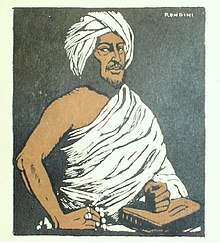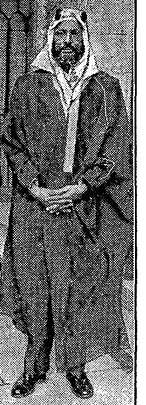Ogaden (clan)
| Regions with significant populations | |
|---|---|
| Languages | |
| Somali | |
| Religion | |
| Islam (Predominantly Sunni, Sufism) | |
| Related ethnic groups | |
| Jidwaq, Absame, Marehan, other Darod groups, and other Somali clans |
The Ogaden (Somali: Ogaadeen, Arabic: أوغادين) is a Somali clan. The largest Darod subclan. Ogaden people mainly inhabit in Somali Region, Jubaland and NFD (kenya).
Overview

Members of the Ogaden clan primarily live in the central Ogaden plateau of Ethiopia (Somali Region),[1] the North Eastern Province of Kenya, and the Jubaland region of Southern Somalia. They also inhabit Somalia's major cities such as Mogadishu and Kismayo.

The Ogaden clan is known for resisting colonialism during the Dervish era and in Jubaland and North Eastern Province in Kenya when both were colonized by the British. Members of the Ogaden clan were fighting European colonizers in 2 of the 3 regions, the Somali territories were split into by colonial borders; Somali region in Ethiopia, Jubaland in Southern Somalia and the North Eastern Province. The most known anti-colonial Somali, Sayid Mohammed Abdullah Hassan hails from the Ogaden clan.
According to Human Rights Watch, the Ogaden is the largest Darod clan in Ethiopia's Somali Region, and may account for 80 to 90 percent of the Somali population in Ethiopia.[2] The Ogaden clan "constitutes the backbone of the ONLF".[3] In particular, the ONLF operates in Ogaden areas[4]
Frank Linsly James, one of the first Europeans to travel deep into Ogaden territory while being accompanied by Lord Philips and armed with Martini-Enfield rifles, describes his first encounter with Ogadens in 1884.
After marching for six hours, we were joined by two Ogadayn natives, who said they would show us the wells, which were close at hand. They pointed to our guns and asked their use. When we said, "for killing men and beasts," they laughed, and replied " they would be no use against sticks, let alone swords and spears." A Hornbill was sitting on a tree listening to this conversation, and echoed the natives' laugh with an assenting croak of scorn. Lord Phillips raised his despised firearm, and down fell the lifeless hornbill. Down, too, fell the Ogadayn natives, and remained for some time with their faces pressed against the ground, invoking the protection of the great Allah. [5]
Clan tree
There is no clear agreement on the clan and sub-clan structures and many lineages are omitted. The following listing is taken from the World Bank's Conflict in Somalia: Drivers and Dynamics from 2005 and the United Kingdom's Home Office publication, Somalia Assessment 2001.[6][7]
- Darod (Daarood)
- Marehan
- Red Dini
- Rer Hassan
- Cali Dheere
- Kabalah
- Absame
- Ogaden
- (Maqaabul)
- Cawlyahan
- Bahgeri
- mohamed zuber
- Abdalla
- Abudwaq
- Jidwaq
- Ogaden
- Harti
- Dhulbahante (Dolbahante)
- Warsangali (Warsengeli)
- Dishiishe (Dishishe)
- Majeerteen (Mijerteen)
- Absame
- Marehan
In Puntland the World Bank shows the following:[8]
- Darod
- Harti
- Absame (Ogaden)
- Marehan
- Awrtable
- Lelkase
Notable persons
- Mohammed Abdullah Hassan, the Sayyid; religious and nationalist leader of the Dervish movement; called the Mad Mullah by the British
- General Hussein Moallim, former Somali Army General who was incontrol of the port city of Berbera in Northern Somalia (hes was killed by the snm militants).
- Aden Abdullahi Nur Gabiyow, former Minister of Defence of Somalia
- Mahamoud Mohamed Former Chief of General Staff of the Kenya Defence Forces from 1980 to 1998.
- Admiral Mohammed Omar Osman, current ONLF chairman
- Bashir Bililiqo, leader of the anti-Barre Somali Patriotic Movement
- Asli Hassan Abade, first Somali female pilot
- Farah Maalim, former Deputy Speaker of the National Assembly of Kenya
- Aden Bare Duale, the mijority leader of the Kenyan parliament
- Hassan Abdullah Hersi al-Turki, Islamist leader in Somalia and military leader in the Islamic Courts Union
- Mohamed Abdi Mohamed ("Gandhi"), former Minister of Defense of Somalia; prominent anthropologist and activist
- Mohamed Yusuf Haji, former Minister of Defence and acting Minister of Internal Security and Provincial Affairs in Kenya
- Nuruddin Farah, renowned writer and winner of the 1998 Neustadt International Prize for Literature
- Ugaas Abdulrahman Muhumad Qani, former President of the Somali Region in Ethiopia
- Ahmed Mohamed Islam, President of Jubbaland, chairman of the Raskamboni movement
- Hassan Abdillahi, founder and President of Ogaal Radio
- Shukran Hussein Gure, MP for Garissa County
- Sheikh Abdi Qani Sheikh Ahmed Aw adan, Minister of Justice and Religion Affairs 1970-1973[9]
- Mahamoud Mohamed, former Chief of General Staff of the Kenya Defence Forces
- Hussein Maalim Mohamed, Minister of State in the office of the presidency
- Aden Bare Duale, current Majority Leader in the Kenyan Parliament
- Nathif Jama Adam, Governor of Garissa County and former Head of the Sharjah Islamic Bank's Investments & International Banking Division
- Abdirahman Ali Hassan, Wajir county senator and the deputy minority leader in the senate house from 2013-2017, assistant minister of trade 2005-2007, Wajir south constituency MP, 2002-2013
- Ayaan and Idyl Mohallim, twin fashion designers who founded women's fashion line, Mataano.
- Aar Maanta, a Somali-British singer-songwriter, actor, composer, instrumentalist and music producer.
References
- ↑ "Collective Punishment", p. 14
- ↑ "Collective Punishment", p. 13
- ↑ "Collective Punishment", p. 4
- ↑ "Collective Punishment", p. 27
- ↑ The Unknown Horn of Africa: An Exploration From Berbera to the Leopard River, By Frank Linsly james, p.104
- ↑ Worldbank, Conflict in Somalia: Drivers and Dynamics, January 2005, Appendix 2, Lineage Charts, p.55 Figure A-1
- ↑ Country Information and Policy Unit, Home Office, Great Britain, Somalia Assessment 2001, Annex B: Somali Clan Structure Archived 2011-07-16 at the Wayback Machine., p. 43
- ↑ Worldbank, Conflict in Somalia: Drivers and Dynamics, January 2005, Appendix 2, Lineage Charts, p.57 Figure A-3
- ↑ Mukhtar, Mohamed Haji (2003-02-25). Historical Dictionary of Somalia. ISBN 9780810866041.